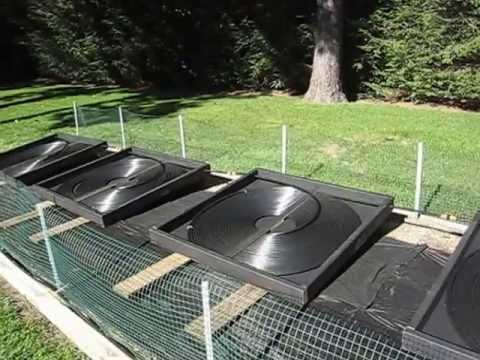One of the most cost-effective solar pool heating method is to get it a solar cover or a blanket. A perfect method suggested by almost all swimming pool builders. Covering your pool with a cover can easily extend the pool season for you by 60 days. There are a number of other benefits of using a solar pool cover like it directly converts the solar radiations into usable heat that can be used by your pool. It normally increases the temperature of the pool by five degrees for next 12 hours. I`. However, another more effective method is to create your own solar heater with some extra efforts.

Figure 1: DIY Pool Heater
The one we are talking about here is a very simple assembly. It mainly uses a photovoltaic unit that offers free power as and when it gets in touch with sunlight. It happens when you wish to run the pump, it also utilizes a small DC submersible pump along with some black landscaping tubing. You can also utilize any pre-existing pump to make this project work. You might be thinking of placing the tubing on the roof but it will only increase stress on your pre-used pump. It can also lead to increase in power bills and shorten the life of pump you are using. Instead, a PV panel and mini submersible pump can pay for itself.
The raw materials required for making your own solar heater are a 12VDC submersible pump, a solar PV panel, a 1, 000 feet of 1/4th black, plastic landscape tubing, and special mounting for tubing. You can start by cutting the tubing in various lengths, the only thing to take care here is that never cut the tubing with excessive length as it would lead to overheating of water before it is pumped out. Better idea is to make parallel tracks and keep them as short as possible. Now arrange the tubes and start making the connections with the help of “I” junctions and joiners. You can now assemble the panel. Another option is to mount tubing over the sheet of a plywood board that is painted black. You can also opt for laying the tubes over the ground close to the pool. If these are placed over cement by any chance they will also pick up the heat radiated from cement. Now you can place the panel in sunlight and slant it slightly in its direction. Keeping the panel over ground would reduce the pressure off the pump in a considerable manner. You can now connect the PV with the pump and drop the pump in the water.
This arrangement will shut off automatically at night, it will run slower when the weather is cloudy. You can never forget to turn it on over sunny days, that will be automatic.
Filed Under: Reviews


Questions related to this article?
👉Ask and discuss on EDAboard.com and Electro-Tech-Online.com forums.
Tell Us What You Think!!
You must be logged in to post a comment.